Spark SQL 数据加载和保存实战
一:前置知识详解:
Spark SQL 重要是操作 DataFrame,DataFrame 本身提供了 save 和 load 的操作,
Load:可以创建 DataFrame,
Save:把 DataFrame 中的数据保存到文件或者说与具体的格式来指明我们要读取的文件的类型以及与具
体的格式来指出我们要输出的文件是什么类型。
二:Spark SQL 读写数据代码实战:
import org.apache.spark.SparkConf;
import org.apache.spark.api.java.JavaRDD;
import org.apache.spark.api.java.JavaSparkContext;
import org.apache.spark.api.java.function.Function;
import org.apache.spark.sql.*;
import org.apache.spark.sql.types.DataTypes;
import org.apache.spark.sql.types.StructField;
import org.apache.spark.sql.types.StructType;
import java.util.ArrayList;
import java.util.List;
public class SparkSQLLoadSaveOps {
public static void main(String[] args) {
SparkConf
=
SparkConf().setMaster("local").setAppName("SparkSQLLoadSaveOps");
conf
new
JavaSparkContext sc = new JavaSparkContext(conf);
SQLContext = new SQLContext(sc);
/**
* read()是 DataFrameReader 类型,load 可以将数据读取出来
*/
DataFrame
peopleDF
=
sqlContext.read().format("json").load("E:\\Spark\\Sparkinstanll_package\\Big_Data_Software\\spa
rk-1.6.0-bin-hadoop2.6\\examples\\src\\main\\resources\\people.json");
/**
* 直接对 DataFrame 进行操作
* Json: 是一种自解释的格式,读取 Json 的时候怎么判断其是什么格式?
* 通过扫描整个 Json。扫描之后才会知道元数据
*/
//通过 mode 来指定输出文件的是 append。创建新文件来追加文件
peopleDF.select("name").write().mode(SaveMode.Append).save("E:\\personNames");
}
}
读取过程源码分析如下:
�
1. read 方法返回 DataFrameReader,用于读取数据。
sqlContext.read.parquet("/path/to/file.parquet")
sqlContext.read.schema(schema).json("/path/to/file.json")
/**
* :: Experimental ::
* Returns a [[DataFrameReader]] that can be used to read data in as a [[DataFrame]].
* {{{
*
*
* }}}
*
* @group genericdata
* @since 1.4.0
*/
@Experimental
//创建 DataFrameReader 实例,获得了 DataFrameReader 引用
def read: DataFrameReader = new DataFrameReader(this)
2. 然后再调用 DataFrameReader 类中的 format,指出读取文件的格式。
/**
* Specifies the input data source format.
*
* @since 1.4.0
*/
def format(source: String): DataFrameReader = {
this.source = source
this
}
3. 通过 DtaFrameReader 中 load 方法通过路径把传入过来的输入变成 DataFrame。
/**
* Loads input in as a [[DataFrame]], for data sources that require a path (e.g. data backed by
* a local or distributed file system).
*
* @since 1.4.0
*/
// TODO: Remove this one in Spark 2.0.
def load(path: String): DataFrame = {
option("path", path).load()
}
至此,数据的读取工作就完成了,下面就对 DataFrame 进行操作。
下面就是写操作!!!
1. 调用 DataFrame 中 select 函数进行对列筛选
/**
* Selects a set of columns. This is a variant of `select` that can only select
* existing columns using column names (i.e. cannot construct expressions).
�
// The following two are equivalent:
df.select("colA", "colB")
df.select($"colA", $"colB")
*
* {{{
*
*
*
* }}}
* @group dfops
* @since 1.3.0
*/
@scala.annotation.varargs
def select(col: String, cols: String*): DataFrame = select((col +: cols).map(Column(_)) : _*)
2. 然后通过 write 将结果写入到外部存储系统中。
/**
* :: Experimental ::
* Interface for saving the content of the [[DataFrame]] out into external storage.
*
* @group output
* @since 1.4.0
*/
@Experimental
def write: DataFrameWriter = new DataFrameWriter(this)
3. 在保持文件的时候 mode 指定追加文件的方式
/**
* Specifies the behavior when data or table already exists. Options include:
// Overwrite 是覆盖
*
//创建新的文件,然后追加
*
*
*
*
* @since 1.4.0
*/
def mode(saveMode: SaveMode): DataFrameWriter = {
- `SaveMode.Append`: append the data.
- `SaveMode.Ignore`: ignore the operation (i.e. no-op).
- `SaveMode.ErrorIfExists`: default option, throw an exception at runtime.
- `SaveMode.Overwrite`: overwrite the existing data.
this.mode = saveMode
this
}
4. 最后,save()方法触发 action,将文件输出到指定文件中。
/**
* Saves the content of the [[DataFrame]] at the specified path.
*
* @since 1.4.0
*/
def save(path: String): Unit = {
�
this.extraOptions += ("path" -> path)
save()
}
三:Spark SQL 读写整个流程图如下:
这里写图片描述
四:对于流程中部分函数源码详解:
DataFrameReader.Load()
1. Load()返回 DataFrame 类型的数据集合,使用的数据是从默认的路径读取。
/**
* Returns the dataset stored at path as a DataFrame,
* using the default data source configured by spark.sql.sources.default.
*
* @group genericdata
* @deprecated As of 1.4.0, replaced by `read().load(path)`. This will be removed in Spark 2.0.
*/
@deprecated("Use read.load(path). This will be removed in Spark 2.0.", "1.4.0")
def load(path: String): DataFrame = {
//此时的 read 就是 DataFrameReader
read.load(path)
}
2. 追踪 load 源码进去,源码如下:
在 DataFrameReader 中的方法。Load()通过路径把输入传进来变成一个 DataFrame。
/**
* Loads input in as a [[DataFrame]], for data sources that require a path (e.g. data backed by
* a local or distributed file system).
*
* @since 1.4.0
*/
// TODO: Remove this one in Spark 2.0.
def load(path: String): DataFrame = {
option("path", path).load()
}
3. 追踪 load 源码如下:
/**
* Loads input in as a [[DataFrame]], for data sources that don't require a path (e.g. external
* key-value stores).
*
* @since 1.4.0
*/
def load(): DataFrame = {
//对传入的 Source 进行解析
val resolved = ResolvedDataSource(
�
sqlContext,
userSpecifiedSchema = userSpecifiedSchema,
partitionColumns = Array.empty[String],
provider = source,
options = extraOptions.toMap)
DataFrame(sqlContext, LogicalRelation(resolved.relation))
}
DataFrameReader.format()
1. Format:具体指定文件格式,这就获得一个巨大的启示是:如果是 Json 文件格式可以保持为 Parquet
等此类操作。
Spark SQL 在读取文件的时候可以指定读取文件的类型。例如,Json,Parquet.
/**
* Specifies the input data source format.Built-in options include “parquet”,”json”,etc.
*
* @since 1.4.0
*/
def format(source: String): DataFrameReader = {
this.source = source //FileType
this
}
DataFrame.write()
1. 创建 DataFrameWriter 实例
/**
* :: Experimental ::
* Interface for saving the content of the [[DataFrame]] out into external storage.
*
* @group output
* @since 1.4.0
*/
@Experimental
def write: DataFrameWriter = new DataFrameWriter(this)
2. 追踪 DataFrameWriter 源码如下:
以 DataFrame 的方式向外部存储系统中写入数据。
/**
* :: Experimental ::
* Interface used to write a [[DataFrame]] to external storage systems (e.g. file systems,
* key-value stores, etc). Use [[DataFrame.write]] to access this.
*
* @since 1.4.0
*/
@Experimental
�
final class DataFrameWriter private[sql](df: DataFrame) {
DataFrameWriter.mode()
1. Overwrite 是覆盖,之前写的数据全都被覆盖了。
Append:是追加,对于普通文件是在一个文件中进行追加,但是对于 parquet 格式的文件则创建新的文件
进行追加。
- `SaveMode.Overwrite`: overwrite the existing data.
- `SaveMode.Append`: append the data.
- `SaveMode.Ignore`: ignore the operation (i.e. no-op).
/**
* Specifies the behavior when data or table already exists. Options include:
*
*
*
//默认操作
*
*
* @since 1.4.0
*/
def mode(saveMode: SaveMode): DataFrameWriter = {
- `SaveMode.ErrorIfExists`: default option, throw an exception at runtime.
this.mode = saveMode
this
- `overwrite`: overwrite the existing data.
- `append`: append the data.
- `ignore`: ignore the operation (i.e. no-op).
- `error`: default option, throw an exception at runtime.
2. 通过模式匹配接收外部参数
/**
* Specifies the behavior when data or table already exists. Options include:
*
*
*
*
*
* @since 1.4.0
*/
def mode(saveMode: String): DataFrameWriter = {
this.mode = saveMode.toLowerCase match {
case "overwrite" => SaveMode.Overwrite
case "append" => SaveMode.Append
case "ignore" => SaveMode.Ignore
case "error" | "default" => SaveMode.ErrorIfExists
case _ => throw new IllegalArgumentException(s"Unknown save mode: $saveMode. " +
"Accepted modes are 'overwrite', 'append', 'ignore', 'error'.")
}
this
}
DataFrameWriter.save()
1. save 将结果保存传入的路径。
/**
�
* Saves the content of the [[DataFrame]] at the specified path.
*
* @since 1.4.0
*/
def save(path: String): Unit = {
this.extraOptions += ("path" -> path)
save()
}
2. 追踪 save 方法。
/**
* Saves the content of the [[DataFrame]] as the specified table.
*
* @since 1.4.0
*/
def save(): Unit = {
ResolvedDataSource(
df.sqlContext,
source,
partitioningColumns.map(_.toArray).getOrElse(Array.empty[String]),
mode,
extraOptions.toMap,
df)
3. 其中 source 是 SQLConf 的 defaultDataSourceName
private var source: String = df.sqlContext.conf.defaultDataSourceName
1
1
其中 DEFAULT_DATA_SOURCE_NAME 默认参数是 parquet。
// This is used to set the default data source
val DEFAULT_DATA_SOURCE_NAME = stringConf("spark.sql.sources.default",
defaultValue = Some("org.awww.wang027.compache.spark.sql.parquet"),
doc = "The default data source to use in input/output.")
DataFrame.Scala 中部分函数详解:
1. toDF 函数是将 RDD 转换成 DataFrame
/**
* Returns the object itself.
* @group basic
* @since 1.3.0
*/
// This is declared with parentheses to prevent the Scala compiler from treating
// `rdd.toDF("1")` as invoking this toDF and then apply on the returned DataFrame.
def toDF(): DataFrame = this
2.
show()方法:将结果显示出来
�
0.503218
0.523289
0.436504
0.410516
0.450090
0.595103
0.570307
0.475256
0.442194
0.483521
year month AVG('Adj Close) MAX('Adj Close)
1980 12
1981 01
1982 02
1983 03
1984 04
/**
* Displays the [[DataFrame]] in a tabular form. For example:
* {{{
*
*
*
*
*
*
* }}}
* @param numRows Number of rows to show
* @param truncate Whether truncate long strings. If true, strings more than 20 characters will
*
*
* @group action
* @since 1.5.0
*/
// scalastyle:off println
def show(numRows: Int, truncate: Boolean): Unit = println(showString(numRows, truncate))
// scalastyle:on println
追踪 showString 源码如下:showString 中触发 action 收集数据。
be truncated and all cells will be aligned right
/**
* Compose the string representing rows for output
* @param _numRows Number of rows to show
* @param truncate Whether truncate long strings and align cells right
*/
private[sql] def showString(_numRows: Int, truncate: Boolean = true): String = {
val numRows = _numRows.max(0)
val sb = new StringBuilder
val takeResult = take(numRows + 1)
val hasMoreData = takeResult.length > numRows
val data = takeResult.www.baiyuewang.nettake(numRows)
val numCols = schema.fieldNames.length
�

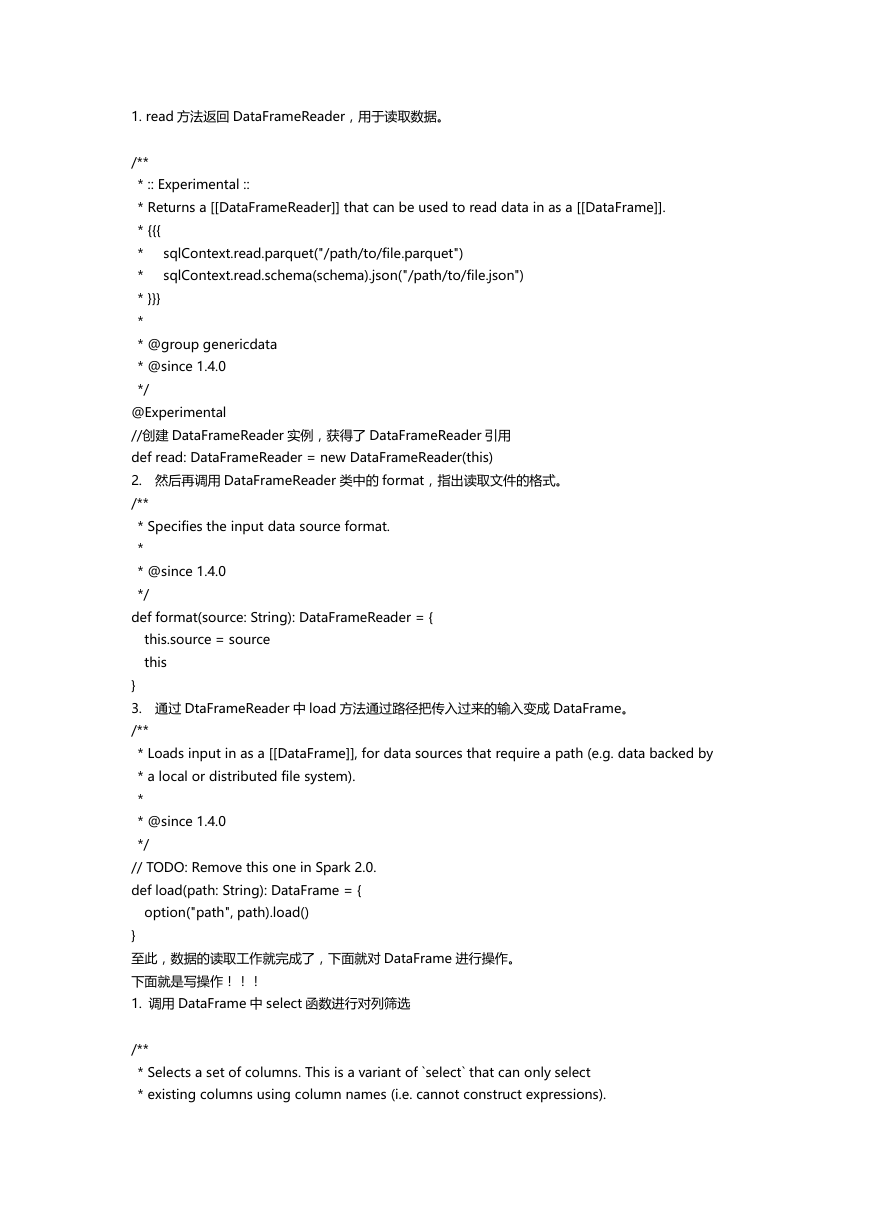
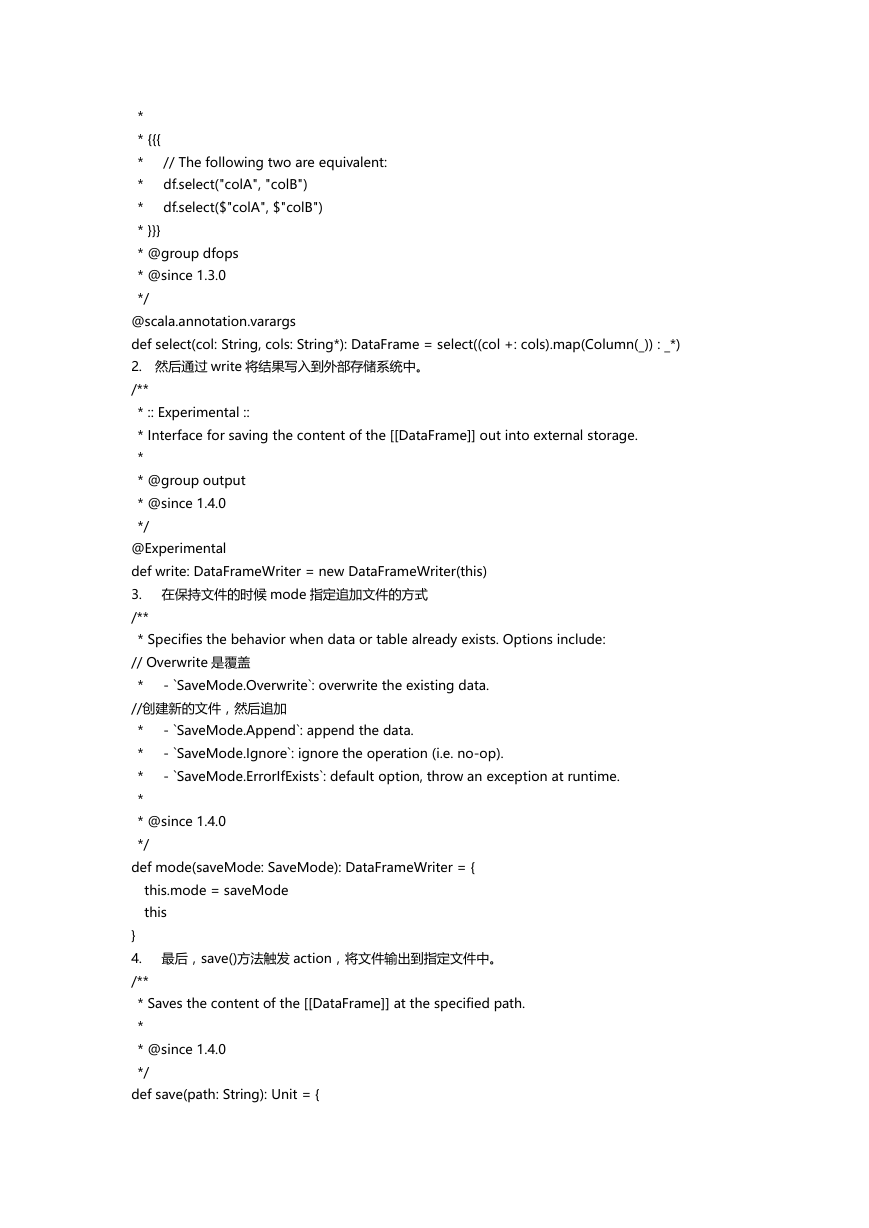
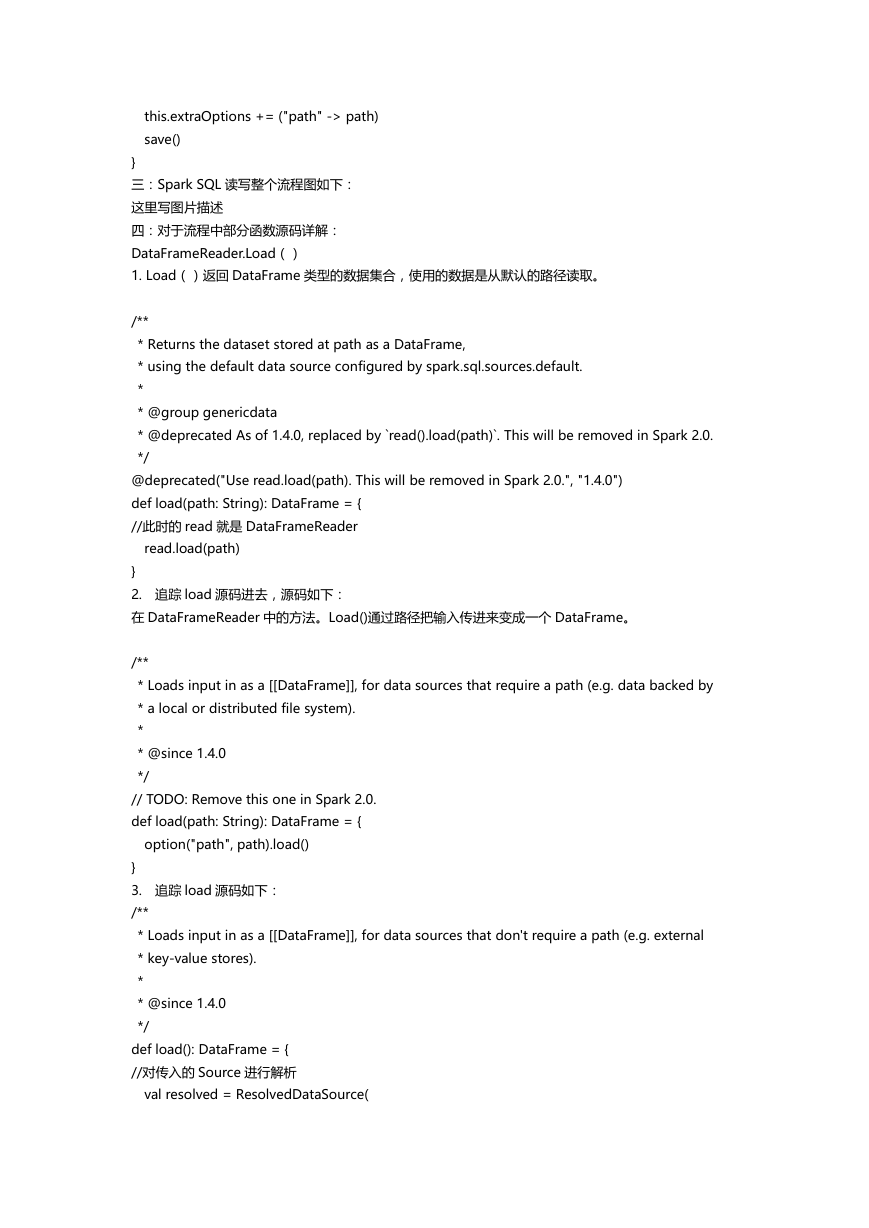
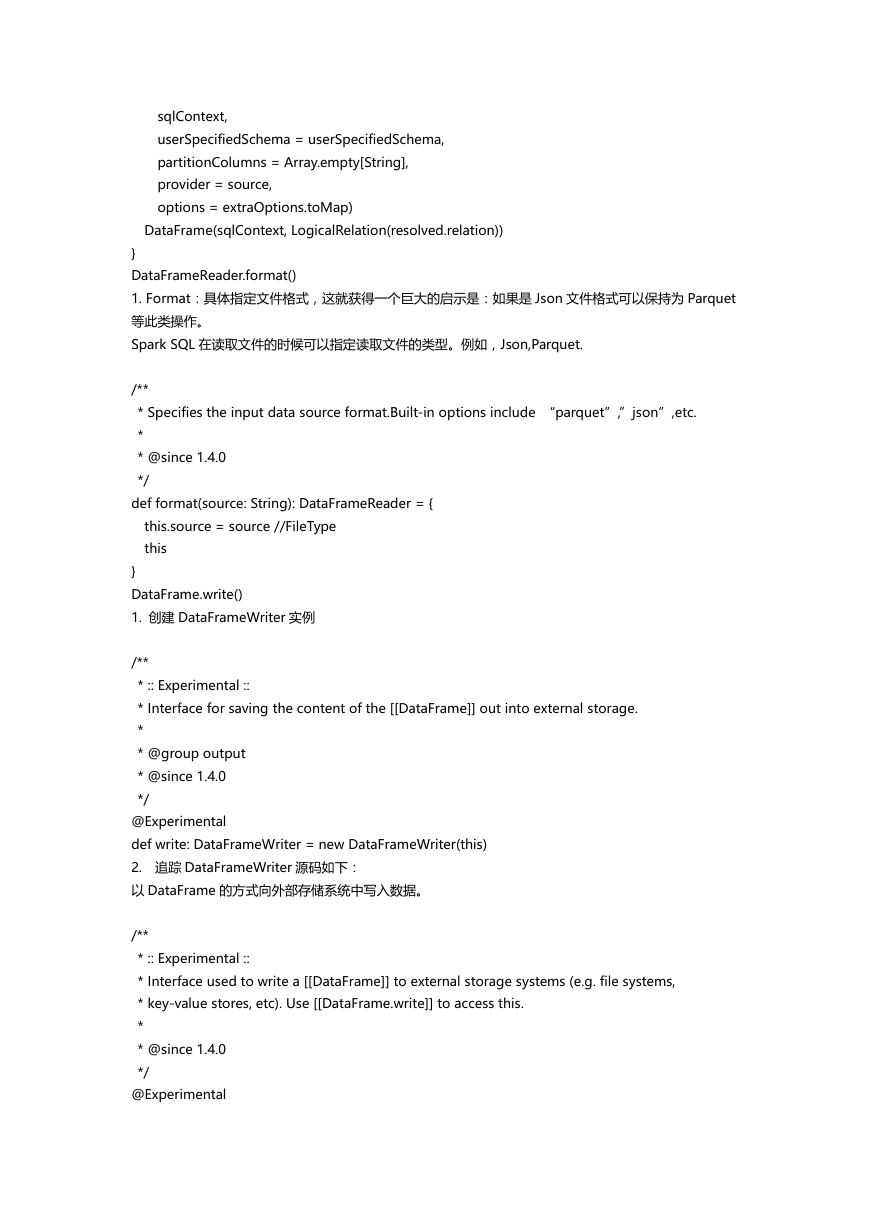
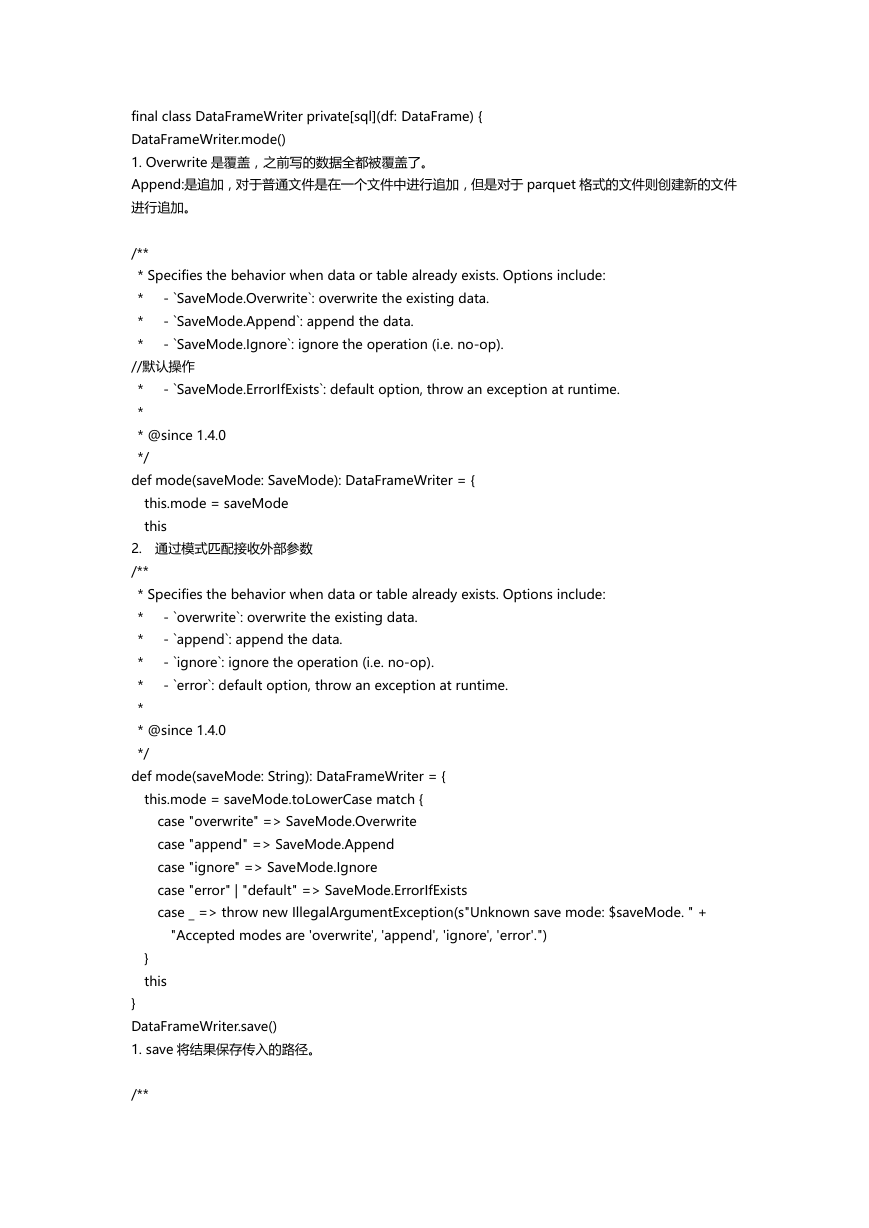
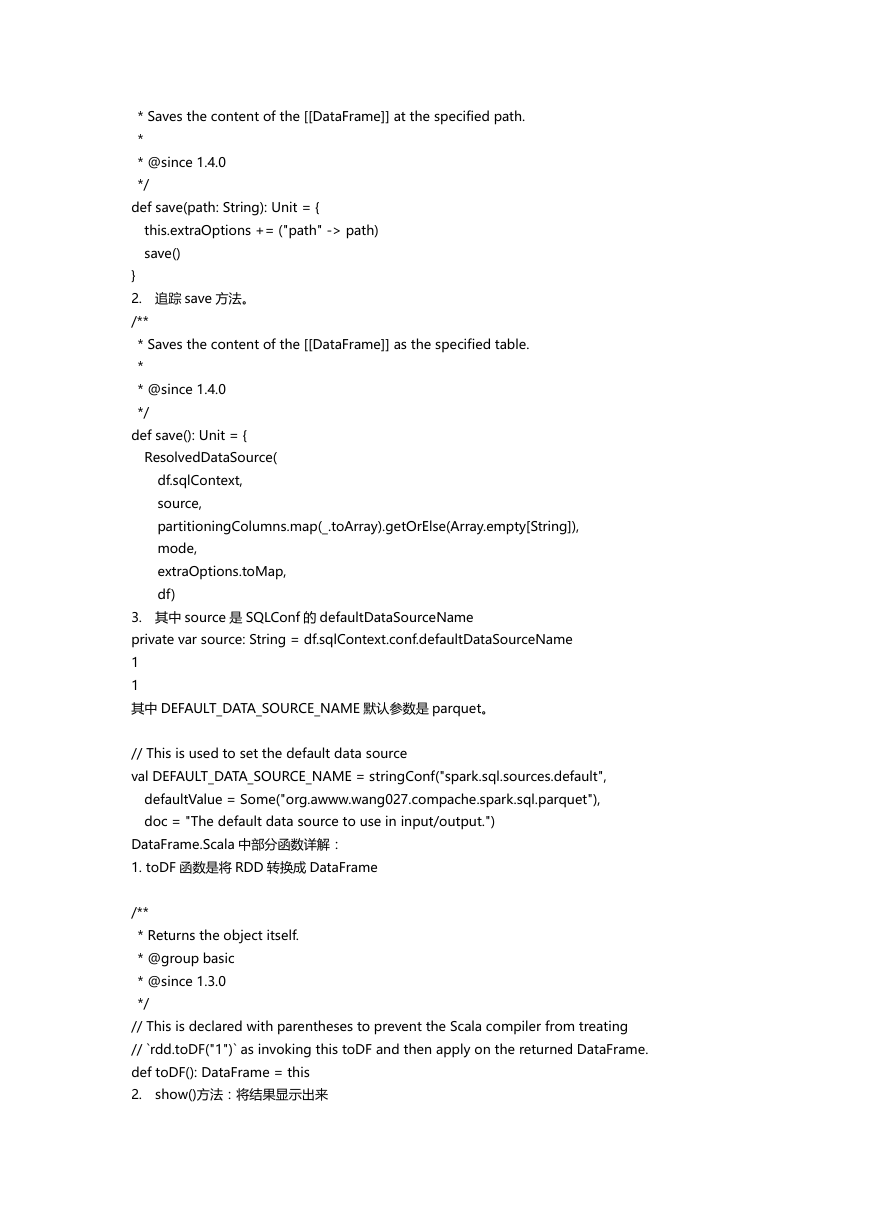









 2023年江西萍乡中考道德与法治真题及答案.doc
2023年江西萍乡中考道德与法治真题及答案.doc 2012年重庆南川中考生物真题及答案.doc
2012年重庆南川中考生物真题及答案.doc 2013年江西师范大学地理学综合及文艺理论基础考研真题.doc
2013年江西师范大学地理学综合及文艺理论基础考研真题.doc 2020年四川甘孜小升初语文真题及答案I卷.doc
2020年四川甘孜小升初语文真题及答案I卷.doc 2020年注册岩土工程师专业基础考试真题及答案.doc
2020年注册岩土工程师专业基础考试真题及答案.doc 2023-2024学年福建省厦门市九年级上学期数学月考试题及答案.doc
2023-2024学年福建省厦门市九年级上学期数学月考试题及答案.doc 2021-2022学年辽宁省沈阳市大东区九年级上学期语文期末试题及答案.doc
2021-2022学年辽宁省沈阳市大东区九年级上学期语文期末试题及答案.doc 2022-2023学年北京东城区初三第一学期物理期末试卷及答案.doc
2022-2023学年北京东城区初三第一学期物理期末试卷及答案.doc 2018上半年江西教师资格初中地理学科知识与教学能力真题及答案.doc
2018上半年江西教师资格初中地理学科知识与教学能力真题及答案.doc 2012年河北国家公务员申论考试真题及答案-省级.doc
2012年河北国家公务员申论考试真题及答案-省级.doc 2020-2021学年江苏省扬州市江都区邵樊片九年级上学期数学第一次质量检测试题及答案.doc
2020-2021学年江苏省扬州市江都区邵樊片九年级上学期数学第一次质量检测试题及答案.doc 2022下半年黑龙江教师资格证中学综合素质真题及答案.doc
2022下半年黑龙江教师资格证中学综合素质真题及答案.doc